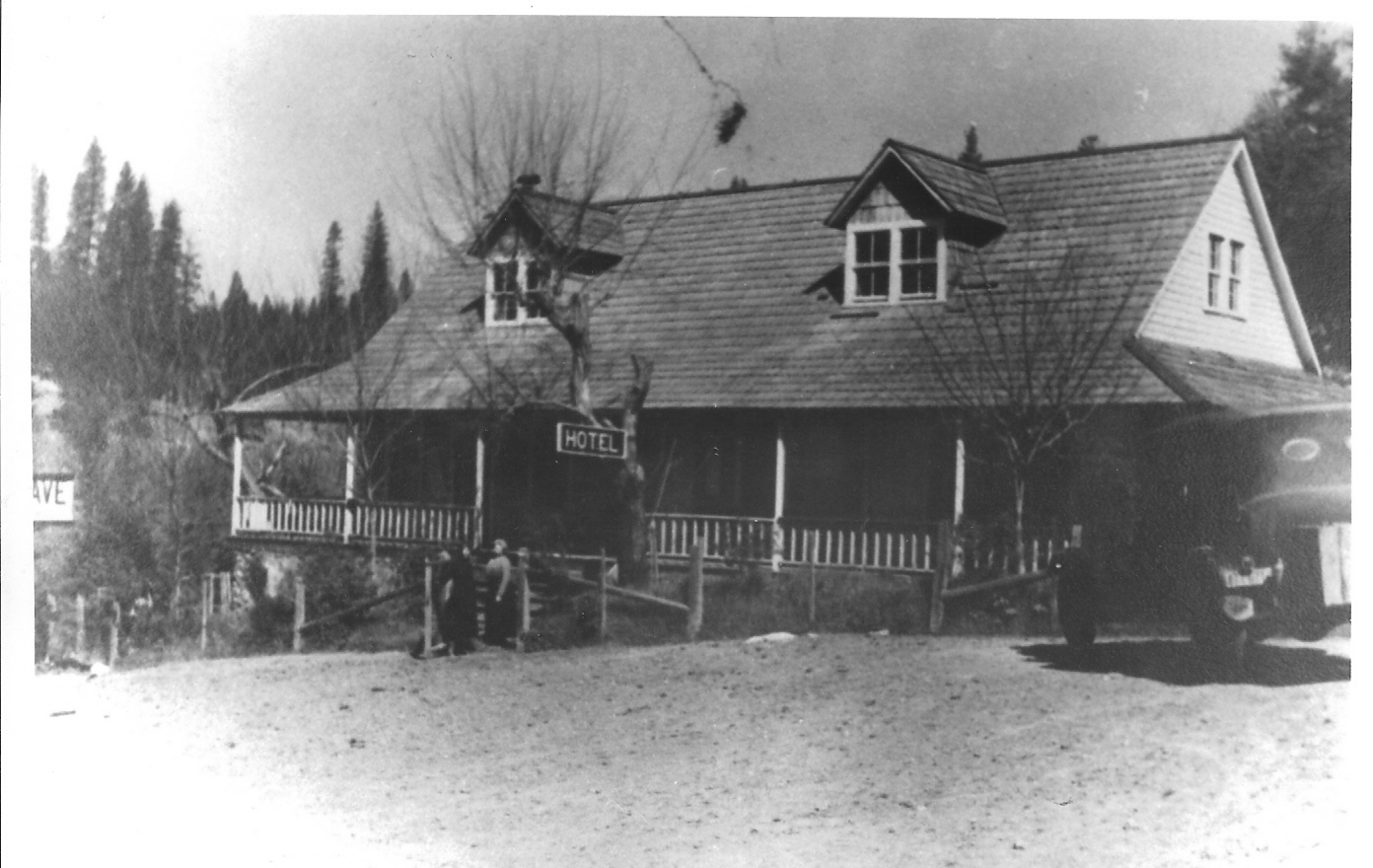 ,CALIFORNIA
,CALIFORNIAHISTORY AND GENEALOGY RESEARCH
THE MUSIC OF DANCE NIGHT IN BOWER CAVE ECHOES FROM PAST FOR OLDSTER
by Joe Collins

Bower Cave Inn-photo donated by Ray Westmoreland
(see Wenger Family Photo Album)
The fiddlers sawed out the first tune of the evening and several dozen dusty boots stomped across the makeshift floor, sending reverberations clean up and out of Bower Cave.
The gathered from far and near, these dancers , and as a social reporter of those days would have phrased it, "and a good time was had by all".
Not now, Bower Cave no longer is attuned to the gaiety of hardbitten miner and their women folk gathered east of Coulterville for some Mariposa County type revelry.
All is Quiet
The cave alongside the old Coulterville toll road now belongs mostly to nesting swallows, a few bats and the watchful eyes of the grand old old man of the cave, George Wenger.
The steps leading down to its entrance are decaying and the water which fills its subterranean passages, constituting of the largest underground lakes in the west, is not as clean as it once was.
In its present condition the cave is no safe for the casual visitor. A few years back a sightseer fell the some 60 feet to the first floor level and died. since then visitors have been discouraged.
Bower Cave now is owned by Mrs. James Rice of Modesto. Wenger, an 82 year old man with a yen for big cigars, takes care of it. He lives in a big old house down the hill from the cave, a house which was built by his ancestors.
The Old Days
He like nothing better than to sit in the shade of a big pine tree and, with a big puff on his cigar- "I'm down to about three a day now".-thinking back to when Coulterville was young and the miners came to promenade at the cave.
From the late 1840's to the early part of the 20th century Coulterville was a center of mining operations and the town grew to a population estimated at between 5,000 and 10,000 including a Chinese settlement of approximately 1,000/
George Wenger remembers all of this. Except for about 15 years in the bay area and in Colorado where he helped string telephone lines through some of the country's highest and roughest mountains, all of his days have been spent in Mariposa County.
Homesteaders
His father and grandfather both were homesteaders. Frederic Wenger, his father, taking over 160 acres of the foothill land. George's father came to the United States from Alsace Lorraine and ended his mitigation in California at the end of a cattle drive from Missouri.
The grandfather bought the property on which the cave is located for $500 from "some squatters'". His name was Henry Becker and about 100 years ago he looked up at a huge sheltering limb near the cave which reminded him of a bower and gave the cave its name.
George's mother was Caroline Becker, born in Columbia and moved on horseback to a ranch near Coulterville when she was barely a year old.
Frederick Wenger was a freighter, a rancher and the keeper of a section of the toll road past his home. It was he who conceived the idea of building a place for the recreation hungry miners to enjoy.
Perfect Acoustics
So he hauled in timbers and constructed the dance floor. He built a stand for the orchestra in the acoustically perfect cave entrance.
They came to dance two or three times a month. Remembers George"
"They danced the schottische the waltz and quadrille, strange stepping in these times but good dancing. The music was made on the violin and guitar and coronet."
And then there were the miners from Cornwall called "Cousin Jack" who came several miles through the woods from the Louisiana Mine they worked. "About 8 or 10 of them I guess, including their women and all."
The Cousin Jacks brought their own instruments, all brass and enough pieces to constitute a band. They were "dern good miners and they could play loud".
One Big Fight
The only old fashioned free for al in George Wenger's memory involved the Cousin Jacks. "They got too much high power in them, you see, and they got in a big fight. Nobody got hurt bad".
This all lasted six or seven years beginning in 1913, and then the floor began to sag and it was all over. As down on the road the horse teams bound for Yosemite National Park gave way to the Model T, the Stanley, White and Doble Steamers, the dance floor gave way to dry rot and dancing feet.
Coulterville faded with the mines and became little more than a sleepy village. The Wenger property was sold and George stayed on as overseer, now all alone in the big house.
Jon Lindberg, son of the famous flyer, came in 1953 and gave the cave widespread publicity by donning skin diving gear to explore its mysteries.
Before the defeat last year of a $163 million bond issue for parks , the state envisioned a 500 acre, $1.35 million Bower Cave State Park to accommodate up to 100 over-night visitors, and it still may become a park some day.
There have been private plans for the cave, but mostly it remains known but to few. The Northern California- Yosemite Highway Association is trying to complete the regarding of the old road and this may some day cause the cave to be reopened.
Meanwhile, George Wenger sits down at the house and putters around in his garden, as spry as a young man. Every once in a while he walks up the hill , looks down at the cave floor and thinks of his youth, almost hearing the violin and the guitar and the cornet.
"By Jimminy, they could play pretty."
transcribed from the Modesto Bee and News Herald- August 11, 1963